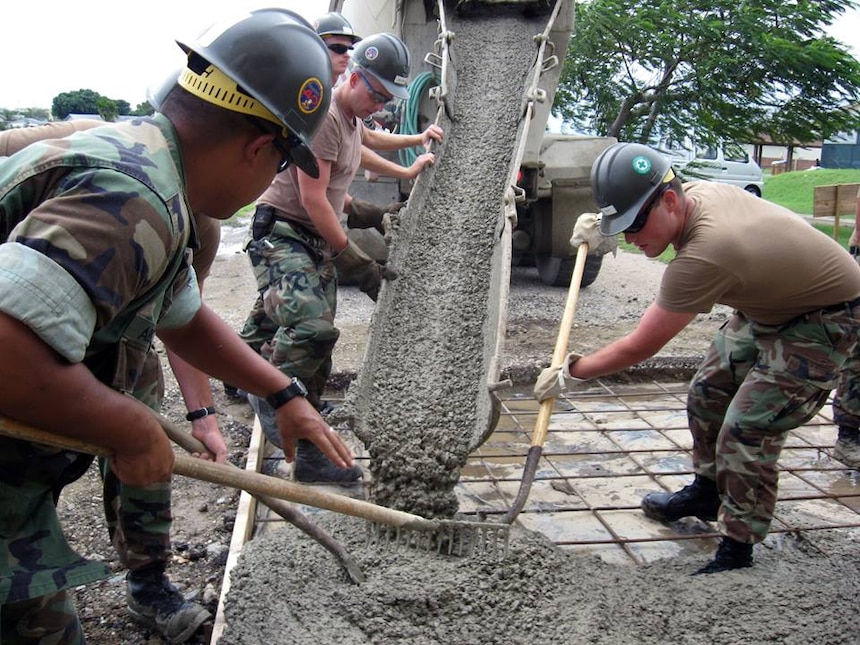Consolidated by U.S. Navy Seabee Museum, Naval History and Heritage Command
October 7
1970: Construction Battalion Unit (CBU) 201 departed Davisville, Rhode Island, for assignment to Antarctica.
October 8
1969: Main body of NMCB 7 departed Davisville, Rhode Island, for assignment at Chu Lai, RVN.
1969: NMCB 7 main body consisting of 14 officers and 538 enlisted men arrived on board Camp Shields, Chu Lai, RVN.
October 9
1942: 31st Naval Construction Battalion (NCB) commissioned at Naval Construction Training Center (NCTC) Camp Endicott, Davisville, Rhode Island.
1969: Main body of Naval Mobile Construction Battalion (NMCB) 58 arrived at NCTC Camp Endicott, Davisville, Rhode Island from Chu Lai, Republic of Vietnam (RVN).
October 10
1942: 30th NCB commissioned at Camp Bradford, Norfolk, Virginia.
1943: 125th NCB commissioned at NCTC Camp Endicott, Davisville, Rhode Island.
1945: 81st NCB inactivated on Guam. 9th Special NCB inactivated at Russells.
1971: Seabee Team 0518 returned to Continental U.S. (CONUS) after completing its deployment to Soc Trang, RVN.
1968: NMCB 8 main body returned to CONUS via commercial and government aircraft from Camp Wilkinson, Phu Bai, RVN.
1969: Cmdr. J.C. Rickels, CEC, USN, commanding officer of NMCB 7, relieved Cmdr. D.J. Mathews, CEC, USN, commanding officer of NMCB 58, at Camp Shields, Chu Lai, RVN.
October 11
1968: Naval Mobile Construction Battalion (NMCB) 121 relieved NMCB 8 at Camp Wilkinson.
1970: Seabee Team 4003 returned from Truk Lagoon, for reassignment to NMCB 40.

October 12
1943: 132nd Naval Construction Battalion (NCB) formed at Naval Construction Training Center (NCTC) Camp Peary, Magruder, Virginia.
1970: The Chief of Naval Operations (CNO) authorized establishment of an underwater facility construction capability within the Naval Construction Force for purposes of engineering, construction and repair of underwater facilities; unofficial names of UCT 1 and UCT 2.
October 13
1942: Chief Machinist Mate Henry L. Thompson, 6th NCB, was the first Seabee killed in action. He died during a Japanese naval bombardment of Henderson Field on Guadalcanal. Thompson and five other Seabees were huddled in a deep dugout to avoid the huge 14-inch armor-piercing naval shells that the Japanese naval task force hurled into the Seabee camp area. One shell landed directly in the hole. The concussion collapsed the sides of the hole, burying the six men. Two Seabees, bravely disregarding their own safety, dug the six men out of the dirt-filled hole. Though the other five men survived, Thompson was found dead, sitting upright in the bottom of the dugout. It was believed that he died from the concussion as much as from suffocation. The two men who dug out the men, Shipfitter 1st Class H.L. Osborn and Shipfitter 1st Class D.L. Gillis, received the Silver Star for their actions.
1966: Cmdr. E.J. Williams, Jr., CEC, USN, commanding officer of NMCB 5 assumed command of Camp Adenir, Da Nang, Republic of Vietnam (RVN).
1969: Main body of Construction Battalion Unit (CBU) 201 deployed from Davisville, Rhode Island for assignment to Commander, Antarctic Support Activities for duty at Antarctica.
1969: Seabee Teams 4005 and 4006 were assigned to the 21st Naval Construction Regiment (NCR) as alert Seabee Teams for 11 weeks of specialized training.
1974: Reserve battalion Naval Mobile Construction Battalion (NMCB) 17 dedicated its permanent drill site at Naval Construction Battalion Center (NCBC) Port Hueneme, California. The drill site was dedicated in memory of Construction Mechanic 2nd Class James W. Lynch and Builder 2nd Class William A. Fulton. These men died of natural causes while members of NMCB 17.